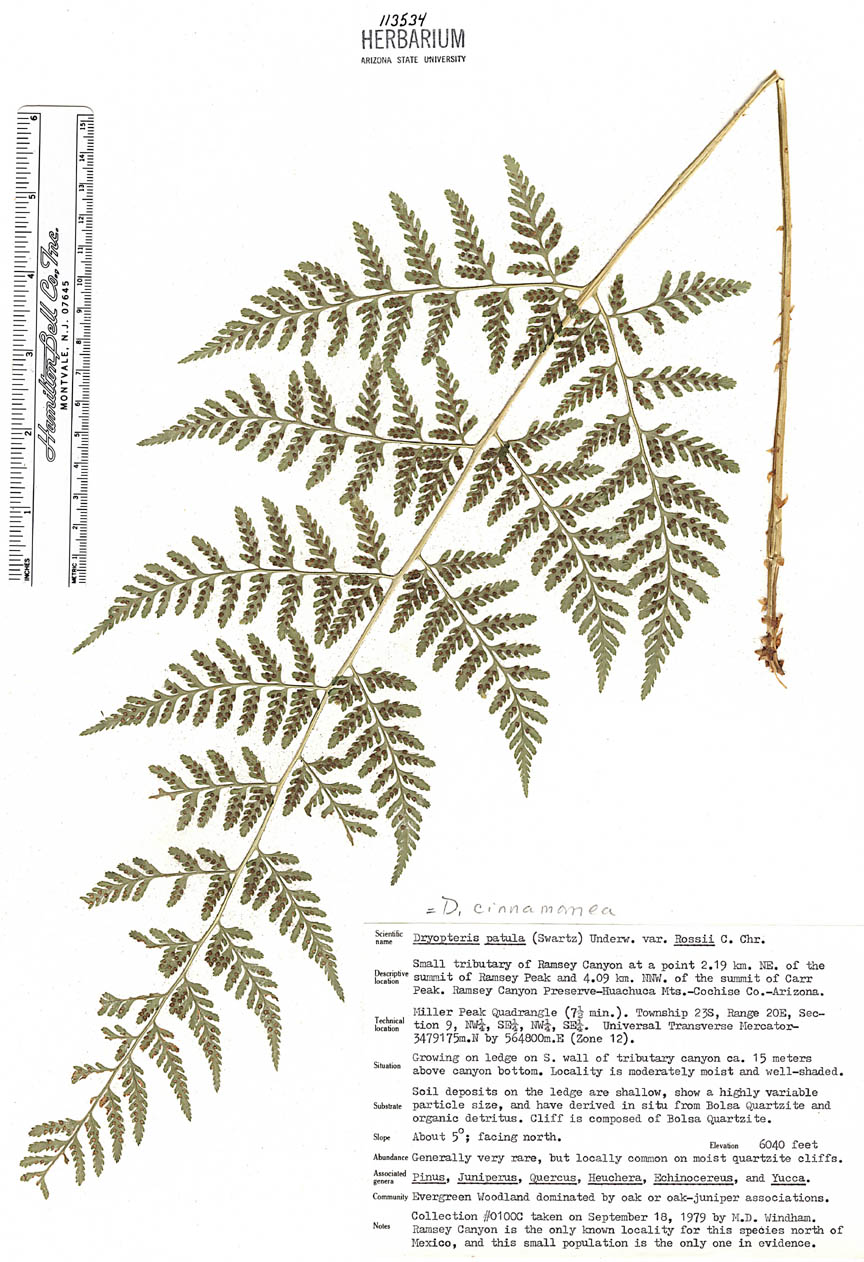
|
Dryopteridaceae |
|
|
Plants perennial, terrestrial or on rock, occasionally hemiepiphytic or epiphytic. Stems creeping to erect, rarely arborescent, sometimes climbing, branched or unbranched, dictyostelic, bearing scales. Leaves circinate in bud, monomorphic or dimorphic. Petiole usually not articulate to stem, scales usually persistent at base, in cross section with 2--many roundish bundles, or bundles 2 and lunate. Blade simple to commonly 1--5-pinnate or more divided, leaf buds absent or present. Veins pinnate or parallel in ultimate segments, simple or forked, free or anastomosing, areoles sometimes with included free veinlets. Indument on blade commonly of glands, hairs, and/or scales, especially on rachis and costae abaxially. Sori borne abaxially on veins or at vein tips (but usually not marginal), or sporangia acrostichoid and covering abaxial surface, if in discrete sori then variously shaped (round, oblong, or elongate); receptacle not or only slightly elevated, with or without indusium, indusium variously linear, falcate, or reniform, sometimes hoodlike, cuplike, or round. Sporangia with stalk of 2--3 rows of cells; annulus vertical, interrupted by stalk. Spores all of 1 kind, usually not green (except Matteuccia , Onoclea ), oblong or reniform in outline, monolete, variously ornamented (often broadly winged), 64 per sporangium (32 in apogamous spp.). Gametophytes green, aboveground, cordate, glabrous or often bearing glands or hairs; archegonia and antheridia borne on lower surface, antheridia 3-celled. The family Dryopteridaceae has been variously circumscribed; it is here delimited in a manner similar to that of R. M. Tryon and A. F. Tryon (1982) but with the inclusion of Nephrolepis . In many works, the family has gone under the illegitimate name Aspidiaceae. Some authorities define Dryopteridaceae more narrowly, to exclude Athyrium , Deparia , Diplazium , Cystopteris , and Gymnocarpium (Athyriaceae or Woodsiaceae), Woodsia (Woodsiaceae), Lomariopsis (Lomariopsidaceae), Nephrolepis (Nephrolepidaceae or Davalliaceae), Onoclea and Matteuccia (Onocleaceae), and Ctenitis and Tectaria (Tectariaceae). Characteristics holding Dryopteridaceae (as circumscribed here) together include the bilateral, monolete spores, often broadly winged perispore, absence of needlelike hairs, scaly stem and petiole bases, abaxial (nonmarginal) sori, base chromosome number of 40 or 41 (also 38 and 39 in Woodsia , 37 in Onoclea , 42 in Cystopteris ), and usually indusiate sori. Loss of indusium, dimorphism, areolate venation, and reduced blade dissection have occurred repeatedly along many evolutionary lines in Dryopteridaceae, and in general these characteristics are often not very useful in delimiting genera or assessing intergeneric relationships. In some genera, especially Phanerophlebia and Polystichum , the blade bears very narrow scales (sometimes called microscales) that resemble uniseriate hairs. These scales may be only one or two cells wide. Every intergradation exists between these filiform microscales and more typical, wider scales, and the two types are the same color, generally tan to brownish. Microscales are probably not homologous with true hairs, which may be either unicellular or multicellular, uncolored or sometimes reddish (as in Tectaria and Ctenitis ), glandular (as in Woodsia ) or not. Hairs in Dryopteridaceae, if present at all, are generally readily distinguishable from the needlelike, transparent ones found in Thelypteridaceae.
|
|
This project was made possible in part by the Institute of Museum and Library Services [MG-70-19-0057-19].
Powered by Symbiota


